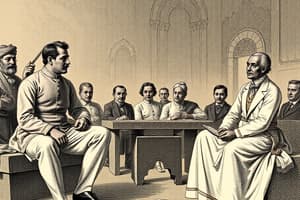Podcast
Questions and Answers
What is the primary role of the upper house in the Indian Parliament?
What is the primary role of the upper house in the Indian Parliament?
- Appointing the Vice President
- Leading the Parliament sessions
- Making laws
- Reviewing legislation passed by the lower house (correct)
Who appoints the Vice President of India?
Who appoints the Vice President of India?
- The President of India
- The Electoral College (correct)
- The Parliament of India
- The Prime Minister of India
Which historical events contributed to India's quest for independence during World War I and II?
Which historical events contributed to India's quest for independence during World War I and II?
- Involvement in World Wars (correct)
- Fall of liberal democracies worldwide
- Formation of the Non-Aligned Movement
- Rise of monarchies in Europe
Which movement was greatly influenced by the events of the First War of Independence in India?
Which movement was greatly influenced by the events of the First War of Independence in India?
What was the main objective of the Muslim League in pre-independent India?
What was the main objective of the Muslim League in pre-independent India?
What major milestone ended the rule of the British East India Company?
What major milestone ended the rule of the British East India Company?
Which document laid the bedrock of contemporary India, inspired by the American model?
Which document laid the bedrock of contemporary India, inspired by the American model?
Who leads the government in India and formulates policies for presentation before Parliament?
Who leads the government in India and formulates policies for presentation before Parliament?
What is the primary role of the President in the Union Parliament and Executive Branches of India?
What is the primary role of the President in the Union Parliament and Executive Branches of India?
In what capacity does the Prime Minister of India primarily function within the government?
In what capacity does the Prime Minister of India primarily function within the government?
Flashcards are hidden until you start studying
Study Notes
History and Civics: A Decade-by-Decade Journey through Constitutional Evolution and Nation Building
In this comprehensive overview, we'll explore the significant milestones spanning over two centuries from our historic origins through constitutional development, parliamentary structures, executive roles, and major movements shaping modern India.
The Foundational Framework: The U.S. Constitution and Indian Independence
The British East India Company's rule ended with the adoption of the Government of India Act 1858, which transferred governance directly under the Crown. However, it was the Constitution of India adopted in 1950—inspired by the American model—that laid the bedrock upon which contemporary India stands. This document enshrined democracy, federalism, and secularism while safeguarding individual freedoms and social justice.
Union Parliament and Executive Branches
President: The head of state performs primarily ceremonial functions (such as appointing judges), yet has some discretionary powers regarding issues like international relations and emergency proclamations.
Prime Minister: The leader of the political party having majority support leads the government, formulates policies and presents them before the Parliament.
Vice President: Appointed indirectly via an electoral college, assists the President during his absence, discharges presidential duties when necessary, and serves as the Chairman of Rajya Sabha (upper house) until a new Chairperson is elected.
The Legislature: Union Parliament
Comprising two houses–Rajya Sabha (Council of States) and Lok Sabha (House of People)-the legislative branch constitutes an integral pillar of democratic India. Lawmaking resides predominantly within the lower house, whereas the upper house is tasked with reviewing legislation passed by the lower chamber, scrutiny over central administrative actions, and representation of states' interests.
First War of Independence and National Movement
Launched against British colonial occupation in 1857, the rebellion marked a turning point in the Indian struggle for self-determination. Though militarily suppressed, the uprisings inspired subsequent freedom movements like Gandhi's Noncooperation Movement (1920-1922), Civil Disobedience Movement (1930-1931), Quit India Movement (1942), and the Nehru Report (1928).
Muslim League and Partition of Bengal
Established in 1906, the Muslim League sought to promote the interest of Muslims in pre-independent India. Demanding separate constituencies for Muslims in elections led to the controversial Partition of Bengal in 1905, reversed seven years later due to popular opposition across religious lines. With Pakistan's formation in 1947, this foresight of cultural separation culminated into one of history’s most traumatic episodes that still reverberates today.
Forward Block and INA Movement
Founded in 1939, the Forward Bloc aimed to create left-leaning policies, active participation in politics, and military strength. Subsequent developments included collaboration between Forward Bloc leaders and members of the Japanese-led Indian National Army (INA), resulting in the Arzi Hukunm (Provisional Government of Free India) and the Red Fort Trials (1945-1946) – events that provoked intense debate over national unity and identity after World War II.
World Wars and Rise of Dictatorship
India's involvement in WWI and WWII helped shape her national consciousness, motivating her towards eventual independence. Meanwhile, Europe witnessed the fall of monarchies and ascension of totalitarian regimes such as Nazi Germany, fascist Italy, and the Soviet Union. These historical shifts broadened understandings of global power dynamics and expanded the discourse on liberal democracies.
Nonaligned Movement and UN Involvement
After achieving independence, India became an influential member of the newly formed Non-Aligned Movement. As a founding member of the United Nations, she continues to advocate peacekeeping missions, human rights protection, and sustainable development worldwide.
Studying That Suits You
Use AI to generate personalized quizzes and flashcards to suit your learning preferences.




